
In an intensely competitive forex environment, traditional content marketing is having to be smarter than ever before. While content marketing is six times more effective than advertising and 62% cheaper, Bt it’s not enough to churn out one size fits all content. Brokers need to be hyper targeting traders to improve their acquisition rate.
Creating and positioning content precisely where and when a trader needs it is critical. That can be a big ask for busy marketing departments and this is where hyper-targeting traders with effective content is driving results.
Current State of Content Marketing for Brokers
Contentworks Co-Founder and Director, Niki Nikolaou, spoke on the topic of hypertargeting marketing funnels at the Financialmarkets.media summit, FMM ’25. A quick survey of a dozen Head of Marketing and CMOs of forex brokers captured a snap-view of the importance of content marketing.
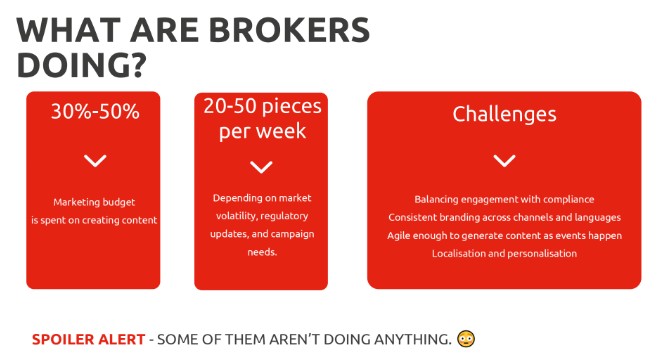
That’s a lot of content to create and deliver on a weekly basis and it’s no surprise that localisation and personalisation are key challenges for broker marketing departments.
Challenges Brokers Face
Brokers face several prominent challenges to hyper-tune trader targeting:
- Ensuring compliance while keeping the content engaging.
- Maintaining branding consistency across interaction channels and languages.
- Remaining agile to produce content as fast as the markets move and opportunities arise.
Hitting the right chord with the audience with every piece that reaches them.
The Solution: Hypertargeting
Hyper-targeting takes personalisation a step further by using detailed data and analytics to target specific audience segments. A survey of consumers and marketers conducted by Adobe™ shows that hypertargeting increases all metrics including loyalty, revenue, retention and acquisition, as well as being efficient cost-wise.
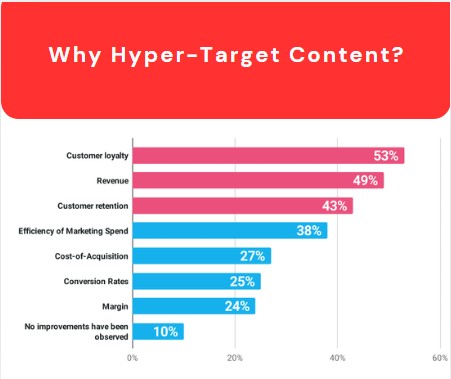
Source: Adobe
Understanding the Trader Mindset
One of the first steps to creating hyper-targeted funnels is to get inside the head of potential traders. While targeting traders is conventionally seen as a B2C approach, it no longer works as well as when brokers shift their strategy to B2B marketing. This is because a B2C strategy targets different decision centres of the brain than a B2B one.
Neuromarketing principles highlight that marketing influences customers’ decision-making to elicit behaviours that benefit the business by understanding their needs. It emphasises that exceptional consumer marketing triggers emotional decision-making. However, traders are encouraged to be prudent, and regulators are on lookout duty. Also, brokers are dealing with people making money decisions. So, much like B2B marketing tells prospects about ROI for their investments, brokers must do the same with traders looking to add to their income through trading.
Plus, the financial markets are volatile and uncertain. This means marketing needs to be dynamic, agile and responsive.
Hyper-Targeting Strategy for Brokers
Hyper-targeting requires reaching the customer where they are, when they need it and offering what they are looking for.
In terms of content marketing for brokers, this translates as: the right message, right timing and right channel.
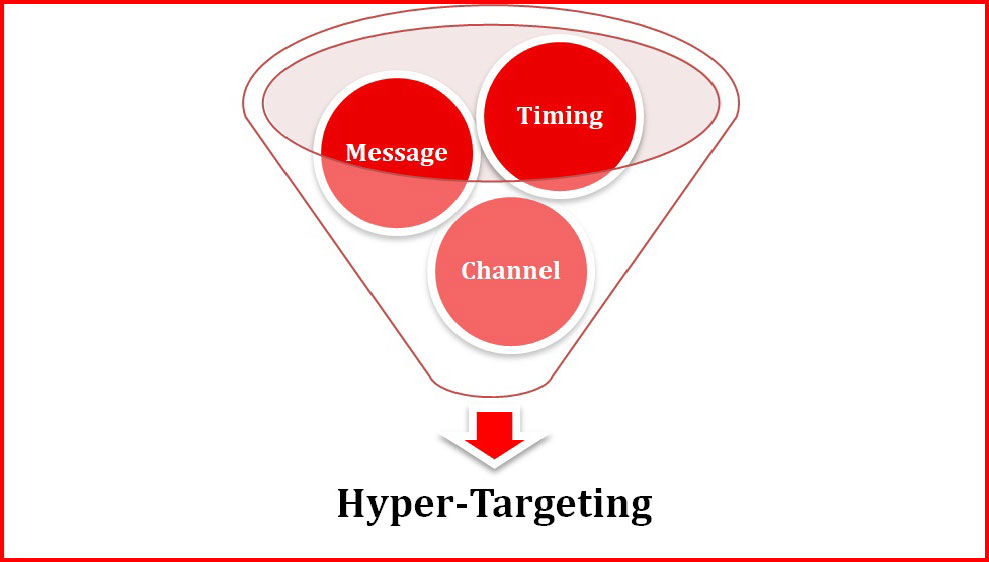
The forex market is global while marketing often needs to be localised. And now, due to the way people are interacting with technology, it must also be hyper-personalised. Brokers have an abundance of data to pull on but marketing teams struggle to manage, analyse and employ it for insights to target their audience.
This is because the data is scattered across siloed systems. For example, for a new trader who just opened a demo account. You could have data across their socials, interactions with your brand, post-conversion interactions, trading history, etc. The fragmentations make understanding each trader challenging.
Additionally, the channels of interaction have multiplied. Carrying out cohesive and unified context-based interactions across multiple channels requires attention to consistent messaging, customer privacy and seamless integration.
To help make sense of all this and turn it into actionable marketing activity, we turn to intent-based marketing.
Intent-Based Marketing
Getting intent based marketing right sees a shorter sales cycle, an increase in efficiency and higher revenue. Intent marketing maps all the information across channels to determine where the customer is in their journey and how can you push them forward in the sales funnel. The days of relying entirely on demographic and geographic segmentation have long gone. The distinctions in needs, habits, and overall user behaviour are diminishing.
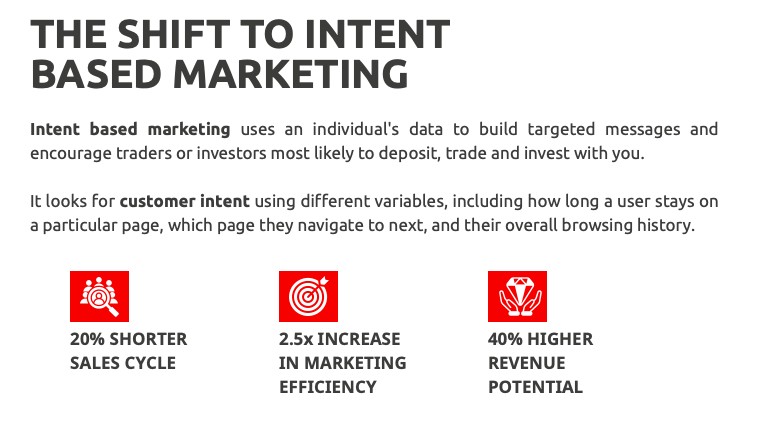
Source: Foundry
This requires leveraging 360° data about the customer. Often, it may be sourced through interactions with your brand, sources from where they reached your brand, their professional data, social media profiles, etc.
Identifying Intent
Intent is the propensity of a prospect to convert into a customer. Brand messaging is tailored to what would work best for each prospect. The message considers the prospect’s concerns, the most effective channel to approach them, and what could encourage action.
Here’s how intent data can vary across four individuals:
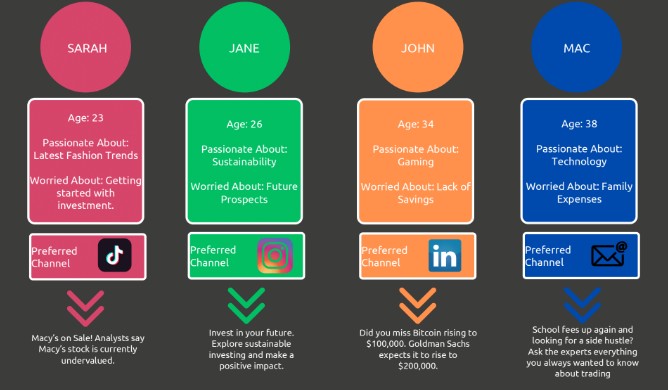
Let’s look at John and how intent facilitates funnelling: John is 34, passionate about gaming and worried about his lack of savings. You’ll find him on Linkedin. He listens to podcasts and watches influencers on social media and YouTube videos. He considers expert insights and opinions valuable. A good way to reach him is through influencer marketing. Invite him to podcasts about trading, consider a gamified approach with quizzes and challenges.
There are different types of intent for potential traders:
- informational (researching strategies)
- transactional (looking at brokers)
- and navigational (searching specific brands).
John, in our example, will work his way through all the above types at some point of your marketing and sales funnel.
Building intent data takes a holistic view of your target clients. And aligning content with the correct intent increases conversions. Clearly, you are not going to develop funnels for each individual but rather for your segments. Thankfully, there are tools to help do just that.
Hyper-targeting Tools to the Rescue
Building intent data needs to take a holistic view. There are tools like Bombora, ZoomInfo and DemandBase that are specifically designed for marketers doing hypertargeting.
There are also tools that you probably already have right now:
- Google Analytics & Search Console: Understanding user behaviour and intent.
- HubSpot, Salesforce: Segmenting traders based on engagement.
- Retargeting platforms (Facebook Pixel, Google Ads, LinkedIn Insight Tag): Re-engaging interested traders.
- Social listening tools (Brandwatch, Sprout Social): Identifying trends and trader sentiment.
Leverage Artificial Intelligence
It is a gigantic a task to collate vast amounts of data, identify the most suitable messaging format and channel, develop the content, and push it to the audience. This is where AI comes to the rescue. Customers are knowledgeable and discerning, they quickly identify mass-produced or AI-generated content. The good news is that AI has several applications to support marketing efforts.
Data-Based Insights
Smart analytics can streamline customer segmentation and profile creation. Tools, such as Sprinklr and Delve AI are great for this.
How to:
Use web crawlers to collect and push in cleansed data to a customer segmentation tool that meets your business’ unique needs.
Exploring Ideas
AI engines can collate data from various aspects of a customer’s life, identify possibilities to pitch new products or services, and rate these possibilities in terms of readiness for a sale to direct your marketing strategy. Tools like Persado and MarketMuse can help optimise messaging for trader audiences.
How to:
Offer detailed prompts to the AI tool regarding your business and target audience to balance maximising tokens activated without hitting the maximum limit to make the most of the potential of AI.
Flip the Script
AI engines are getting smarter by the day. They can discern what a customer may need and what your business has to offer and align them all, to offer more meaningful insights.
How to:
Command your chosen AI tool to ask questions that it thinks will help it better understand your brand and target audience.
Personalise Customer Experiences
Breakthroughs in Gen AI are empowering businesses to improve turnaround times on customer queries. These tools can interact empathetically and contextually with customers to resolve their issues.
How to:
Employ chatbots to improve post-sales experiences and use the interaction data to cross-sell products.
Making the Most of Hyper-Targeting
Businesses are expanding their investments in content marketing, the cornerstone of engagement, building brand authority, and nurturing leads. Hyper-targeting gets the three most important things to drive customers through your sales funnel right: message, timing and channel.
In a nutshell, this is how you approach hypertargeting from a content perspective:
- Strategise and agree on client KPIs
- Identify, research and understand the target audience
- Employ social listening to tune into wants and trends
- Segment the audience by interests, status and intent
- Craft compelling content that speaks to them
- Create effective funnels and lead magnets
- Utilise data and analytics for targeting
- Analysing performance and optimisation.
Final tip to finish off: You worked hard to get them onboard, make sure you nurture your leads and active traders. It’s easier and more cost-effective to retain rather than acquire traders.





